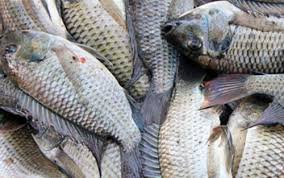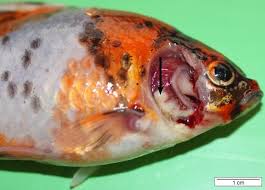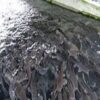Fish disease refers to a condition in which the fish’s body is unhealthy or compromised, deviating from its normal healthy state. It is a state of discomfort or sickness that can reduce the fish’s physiological activities and development. Catfish production, in particular, involves numerous risks and is known as a highly management-intensive form of farming with a high initial investment.
The practice of artificial feeding in densely stocked fish environments increases their metabolic activity, leading to elevated levels of organic wastes and toxic compounds in the ecosystem. This, in turn, encourages the growth of algae, bacteria, and other microorganisms.
Ponds are more challenging to manage than cages or pens in natural water bodies, leading to a build-up of organic waste to toxic levels, such as ammonia and nitrites, contributing to massive algae blooms, particularly blue-green algae.
Blue-green algae are the primary cause of off-flavours in fish. Generally, fish diseases can be categorized into infectious, parasitic, nutritional, and environmental diseases, with environmental, parasitic, and bacterial infections being the most prevalent in tropical areas.
This article will explore various methods for controlling the negative effects of poor water quality in fish farming and the treatment of bacterial infections using medication.
Read Also: Various Types Of Fruits And Their Nutritional Value
Effect of Microbial Attack on Fish Production

In the past, the “low-intensity” management practices used prior to the 1980s generally resulted in good pond water quality and less stress on fish populations. Lower stocking densities also reduced the efficiency of disease transmission.
Over time, with the increase in stocking and feeding rates, and the adoption of multiple-batch cropping systems, new populations of fingerlings were introduced into ponds with existing larger fish populations. These practices led to the rise of infectious diseases as a major limiting factor in catfish production, with disease outbreaks now common, even in well-managed facilities.
Around 45% of inventory losses in catfish fingerling farms are due to infectious diseases. Although data for food-sized fish are scarce, approximately 60% of overall catfish losses from infectious diseases are caused by bacterial infections (single or mixed), 30% by parasitic infestations, 9% by fungal infections, and 1% by viral infections. Multiple or mixed infections in pond-raised catfish complicate treatment decisions.
Economic losses due to infectious diseases are difficult to estimate, as record-keeping varies among farmers and many diseases go unreported. However, infectious diseases are believed to cause millions of dollars in direct fish losses annually.
Additionally, these diseases reduce profitability by increasing treatment costs, reducing fish food consumption, worsening feed conversion ratios, and delaying harvests. Fish-eating birds may also be attracted to ponds with sick or dying fish, causing further losses.
There are disease syndromes whose exact cause remains uncertain, such as channel catfish anemia (CCA), also known as “no blood disease,” and visceral toxicosis of catfish (VTC), believed to be caused by toxins.
When a disease outbreak occurs, effective health management requires three main steps: problem identification, diagnosis, and corrective management, all of which must be carried out promptly to avoid further losses. When multiple factors contribute to the disease, it complicates both diagnosis and corrective management.
Use of Medicated Feed in Catfish Production
Catfish raised in ponds are the most popular species for food fish production in the southeastern United States. Due to crowding and the associated stress in modern aquaculture systems, they are more prone to diseases than free-ranging fish.
Bacterial diseases frequently cause catfish deaths, often as a secondary issue to poor water quality or excessive parasitism. Medicated feeds can control bacterial infections, but unless underlying problems are addressed, the treatment’s effect may only be temporary.
Bacterial Disease in Fish Production
Bacteria are microscopic, single-celled organisms living in water, sediments, fish surfaces, and their intestines. Most bacteria are beneficial, aiding in food digestion, vitamin production, and the breakdown of ammonia and organic debris in the environment.
However, some bacteria are opportunistic pathogens that cause disease under specific conditions. Examples of such bacteria include Aeromonas spp., Pseudomonas spp., and Flexibacter spp., which can cause significant catfish mortality.
Some bacteria, considered obligate pathogens, are more likely to cause disease as the primary issue rather than a secondary problem. There is speculation that Edwardsiella ictaluri may be an obligate pathogen.
Read Also: Cultivation Methods For Different Fruit Trees And Bushes
What is Medicated Feed?

Medicated feed refers to a commercially prepared feed containing an antibiotic, specifically designed to control bacterial infections in channel catfish. However, these feeds do not control parasitic, viral, or fungal diseases.
Only two antibiotics, approved by the U.S. Food and Drug Administration (FDA) for catfish, are used in medicated feed: Terramycin and Romet. Each serves different purposes and has its own specifications.
1. Terramycin
Terramycin contains oxytetracycline and has long been used to treat bacterial diseases in catfish. It is specifically approved by the FDA for controlling infections caused by Aeromonas spp. and Pseudomonas spp. in channel catfish.
Fish must consume a daily dose of 2.5–3.75 grams of the drug per 100 pounds of body weight for 10 days, with a 21-day withdrawal period before the fish can be marketed. During the withdrawal period, no fish should be slaughtered, as doing so would violate federal law.
2. Romet
Romet, approved by the FDA in 1985, contains a combination of sulfadimethoxine and ormetoprim, which are more effective together than individually. This antibiotic is effective against Edwardsiella ictaluri but not Flexibacter spp.
Romet is fed for five days, with a three-day withdrawal period, allowing fish to be slaughtered nine days after treatment starts. A key advantage is its availability as a floating feed, making it easier to observe the fish eating it.
Homemade Medicated Feeds
If commercial medicated feeds are unavailable, it is possible to mix medicated feed at home using premixed antibiotics such as Terramycin soluble powder or Romet-B, though this process is time-consuming and expensive. Binding agents such as vegetable or fish oil can be used to coat the feed with the antibiotic.
Storage of Medicated Feed
Medicated feed should be stored in cool, dry places to prevent the breakdown of antibiotics and essential nutrients. Improper storage may render treatment ineffective. It is advisable to discard unused medicated feed after 3–4 months.
Proactive Pond Management
Implementing proactive pond management can reduce the need for therapeutants. Proper pond preparation, cleanliness, grading fingerlings, regulating stocking density, using high-quality feed, and reducing feeding rates can help maintain a healthy pond environment. Feeding strategies that ensure all fish have access to food can also improve feed efficiency and reduce waste.
Do you have any questions, suggestions, or contributions? If so, please feel free to use the comment box below to share your thoughts. We also encourage you to kindly share this information with others who might benefit from it. Since we can’t reach everyone at once, we truly appreciate your help in spreading the word. Thank you so much for your support and for sharing!
Read Also: Easy Gluten-Free Recipes






